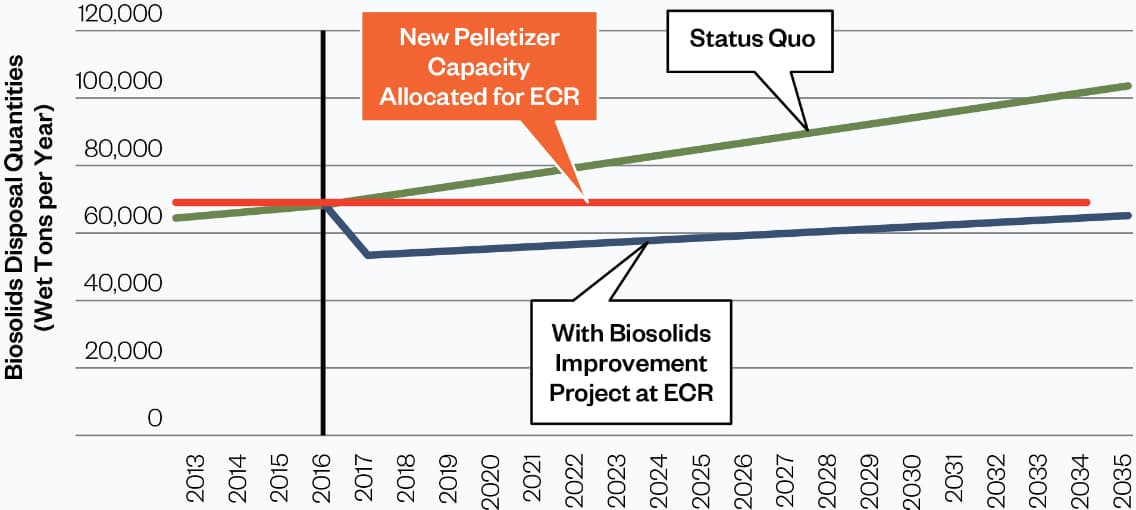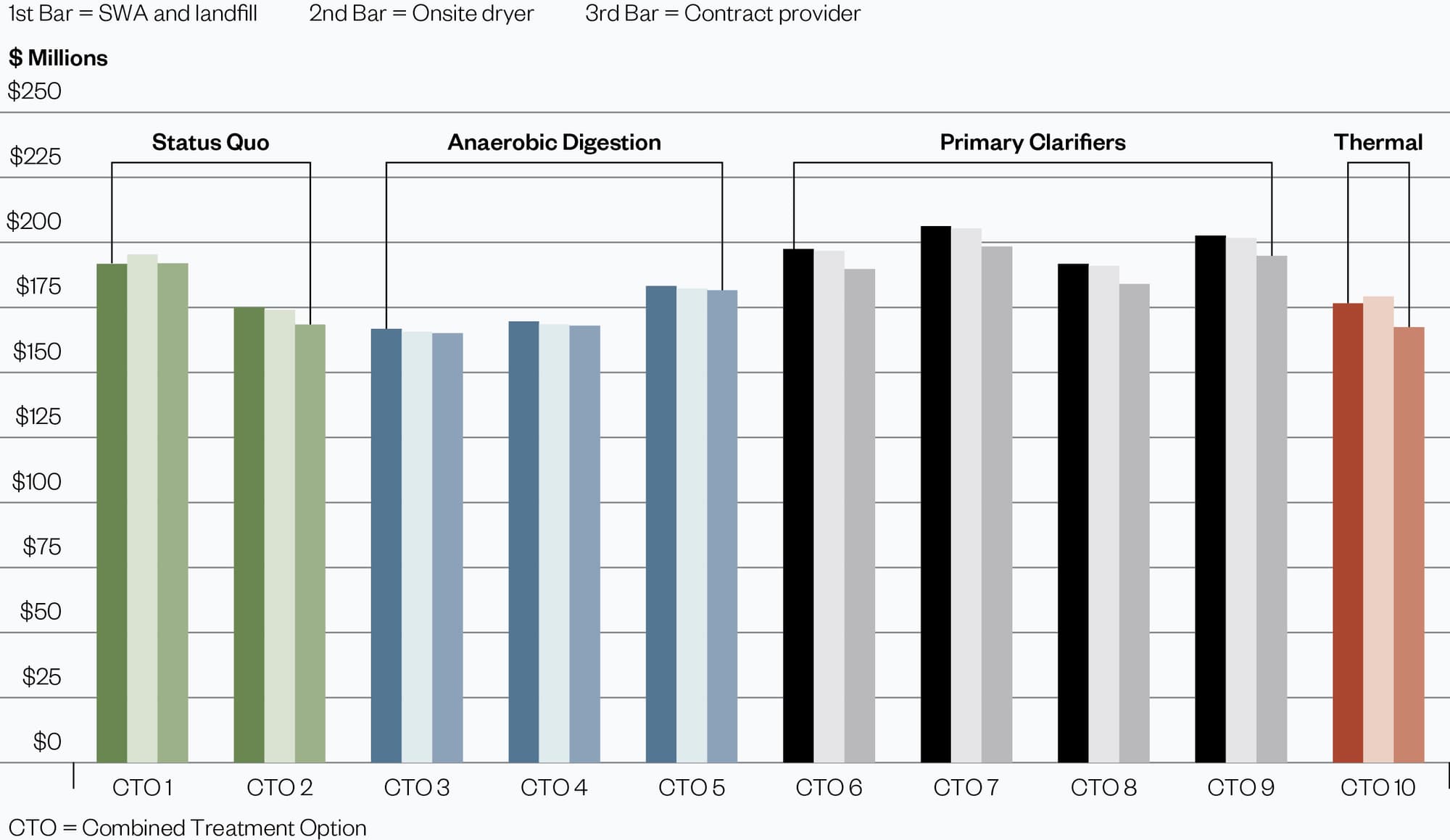Turning up the Heat: Advanced Digestion to Meet Disposal Constraints
Last Modified Feb 28, 2022
The East Central Regional Water Reclamation Facility (ECRWRF) is a 70-mgd conventional activated sludge secondary treatment plant in the West Palm Beach, Florida that serves the Cities of West Palm Beach, Lake Worth and Riviera Beach; the Town of Palm Beach, and the northern half of Palm Beach County. A portion of the main plant’s secondary effluent is discharged to a 22-mgd high-level disinfection facility to meet industrial cooling water demands at the Florida Power and Light West County Energy Center with the balance of secondary effluent discharged to deep injection wells.
Onsite solids treatment has consisted of partial thickening in decant tanks, partial stabilization by aerobic digestion, and belt filter press dewatering. Dewatered cake has been further stabilized at a regional composting facility at a relatively low cost per wet ton. The majority of the plant, including solids treatment infrastructure, was constructed in the 1970s and is reaching the end of its useful service life. From a performance standpoint, decant thickening has been limited and generates odors; aerobic digestion has been limited by inadequate mixing/aeration; and belt filter press dewatering has been limited to 15% cake solids. Until recently solids processing performance and efficiencies were not as critical due to the low unit cost for off-site disposal.
Related Topics:

Increased solids destruction is critical, since projected biosolids disposal quantities, even following conventional digestion and dewatering, will outpace available pelletizer capacity in less than 10 years.
When the regional provider announced plans to close the composting facility and proposed routing biosolids to a regional pelletizer facility at a significantly higher unit disposal cost, the ECRWRF Operating Board commissioned a biosolids study to evaluate the following:
- Solids treatment process to increase solids destruction. Increased solids destruction is critical, since projected biosolids disposal quantities, even following conventional digestion and dewatering, will outpace available pelletizer capacity in less than 10 years.
- Liquid processes to (a) enhance biosolids treatment; and (b) treat recycle flows from proposed solids processing facilities to assure compliance with effluent nutrient limits.
- Economic feasibility of energy and heat recovery from digester gas.
- Multiple residuals management options including the regional pelletizer, onsite drying and third-party vendor treatment and/or disposal.
- Present value life-cycle costs of combined liquids treatment / solids treatment / disposal options to select a recommended overall project approach.

Based on life-cycle cost analyses of 30 combined treatment options, several biosolids improvements were recommended.
Liquid treatment options evaluated included retaining the status quo, conventional primary treatment, and high-rate primary treatment. Solids treatment options included temperature-phased anaerobic digestion and WAS pretreatment using thermal hydrolysis. Biogas energy recovery options included use of existing emergency turbine generators or new reciprocating engines. Disposal options included the regional pelletizer facility, an onsite thermal drying facility, and contracts with third parties. Based on life-cycle cost analyses of 30 combined treatment options, the following biosolids improvements were recommended:
- Convert one decant tank to aerated WAS storage
- Upgrade the dormant gravity belt thickening facility
- Construct new temperature-phased anaerobic digestion facilities with heat recovery
- Construct a new FOG receiving station for co-digestion and increased biogas production
- Construct a new high-solids centrifuge dewatering facility with cake storage hoppers
- Contract with the regional pelletizer facility for biosolids disposal
- Construct a ferric chloride feed facility for struvite control
- Construct a septage receiving facility and pump treated septage to the aeration basins

The temperature-phased anaerobic digestion (TPAD) facility will consist of two thermophilic digesters and four mesophilic digesters in series. Sludge-to-sludge heat exchangers are designed between the two temperature phases to preheat feed sludge to the thermophilic digesters and partially cool thermophilic sludge prior to mesophilic digestion. The sludge heat recovery reduces the sizes of hot water boilers and sludge to hot water heat exchangers at each digester. Mesophilic heat exchangers will use plant service water to complete cooling of sludge to mesophilic temperatures.
FOG will be unloaded by off-site haulers into a storage tank, heated, blended with recirculated digested sludge and fed to the mesophilic digesters in a batch sequence. Co-digestion with FOG will increase biogas production. Excess biogas not used for digester heating may be sold to the regional pelletizer facility to supplement their landfill gas source and eliminate, or at least minimize, the need to purchase natural gas.
Temperature-phased anaerobic digestion is projected to result in a 10% to 15% increase in volatile solids reduction. Coupled with enhanced dewatering by high-solids centrifuges, overall biosolids disposal quantities will be reduced by approximately 35% from the status quo and allow the ECRWRF to meet the regional pelletizer facility’s capacity constraint. This biosolids treatment approach is projected to save the ECRWRF Operations Board up to $25 million over the next 20 years. Construction is underway and startup is scheduled for 2018.
This presentation will address the following in detail:
- Process modeling and life cycle cost evaluation of residuals management options
- Design and predicted performance of the TPAD system, including sludge heat recovery
- Planned procedures for phased startup and testing of biosolids improvements
- Future plans for beneficial use of excess biogas











